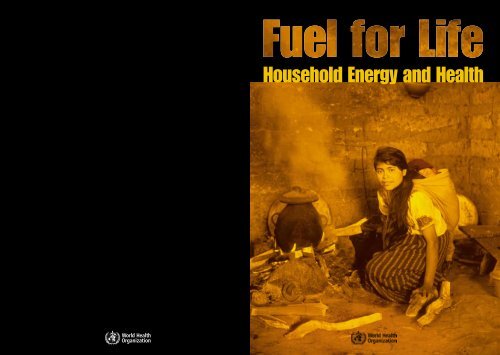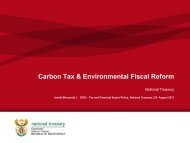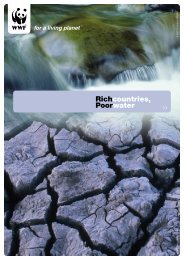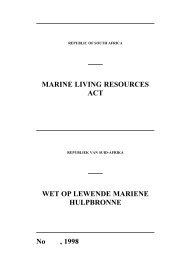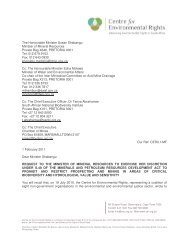Household Energy and Health - World Health Organization
Household Energy and Health - World Health Organization
Household Energy and Health - World Health Organization
You also want an ePaper? Increase the reach of your titles
YUMPU automatically turns print PDFs into web optimized ePapers that Google loves.
<strong>Household</strong> <strong>Energy</strong> <strong>and</strong> <strong>Health</strong>
<strong>Household</strong> <strong>Energy</strong> <strong>and</strong> <strong>Health</strong>WHO Library Cataloguing-in-Publication DataFuel for life : household energy <strong>and</strong> health."Written <strong>and</strong> coordinated by Eva Rehfuess"– Acknowledgements.1. Air pollution, Indoor. 2. Wood fuels. 3. <strong>Energy</strong> policy. 4. Environmental health. 5. Socioeconomic factors. 6. Developing countries. I. Rehfuess, Eva. II. <strong>World</strong> <strong>Health</strong> <strong>Organization</strong>.ISBN 92 4 156316 8 (NLM classification: WA 754)ISBN 978 92 4 156316 1© <strong>World</strong> <strong>Health</strong> <strong>Organization</strong> 2006All rights reserved. Publications of the <strong>World</strong> <strong>Health</strong> <strong>Organization</strong> can be obtained from WHO Press, <strong>World</strong> <strong>Health</strong> <strong>Organization</strong>, 20 Avenue Appia, 1211 Geneva 27, Switzerl<strong>and</strong> (tel: +4122 791 3264; fax: +41 22 791 4857; email: bookorders@who.int). Requests for permission to reproduce or translate WHO publications – whether for sale or for noncommercialdistribution – should be addressed to WHO Press, at the above address (fax: +41 22 791 4806; email: permissions@who.int).The designations employed <strong>and</strong> the presentation of the material in this publication do not imply the expression of any opinion whatsoever on the part of the <strong>World</strong> <strong>Health</strong> <strong>Organization</strong>concerning the legal status of any country, territory, city or area or of its authorities, or concerning the delimitation of its frontiers or boundaries. Dotted lines on maps representapproximate border lines for which there may not yet be full agreement.The mention of specific companies or of certain manufacturers’ products does not imply that they are endorsed or recommended by the <strong>World</strong> <strong>Health</strong> <strong>Organization</strong> in preference to othersof a similar nature that are not mentioned. Errors <strong>and</strong> omissions excepted, the names of proprietary products are distinguished by initial capital letters.All reasonable precautions have been taken by WHO to verify the information contained in this publication. However, the published material is being distributed without warranty of anykind, either express or implied. The responsibility for the interpretation <strong>and</strong> use of the material lies with the reader. In no event shall the <strong>World</strong> <strong>Health</strong> <strong>Organization</strong> be liable for damagesarising from its use.Printed in France
Foreword 4contentsAcknowledgements 5Section 1: <strong>Household</strong> energy, indoor airpollution <strong>and</strong> health<strong>Household</strong> energy: three billion left behind 8<strong>Health</strong> at the heart of the matter 10The killer in the kitchen 12Section 2: <strong>Household</strong> energy <strong>and</strong> theMillennium Development GoalsEnergizing the Millennium Development Goals 16Trapped by energy poverty 18Women <strong>and</strong> children overlooked 20Stripping our forests, heating our planet 22The need for a quantum leap 24Section 3: The way forwardComing clean: modern fuels, modern stoves 28Investing in household energy pays off 30Rolling out household energy programmes: learning from the past 32New household energy horizons 34Key pointsFurther reading 38Annex 39
Foreword<strong>Energy</strong> is essential to meet our most basicneeds: cooking, boiling water, lighting <strong>and</strong>heating. It is also a prerequisite for good health– a reality that has been largely ignored by the worldcommunity.More than three billion people still burn wood,dung, coal <strong>and</strong> other traditional fuels inside theirhomes. The resulting indoor air pollution isresponsible for more than 1.5 million deaths a year– mostly of young children <strong>and</strong> their mothers.Millions more suffer every day with difficulty inbreathing, stinging eyes <strong>and</strong> chronic respiratorydisease. Moreover, indoor air pollution <strong>and</strong>inefficient household energy practices are asignificant obstacle to the achievement of theMillennium Development Goals.Fuel for life, food for thought. With this publicationwe draw attention to a serious neglected publichealth problem. Effective solutions exist <strong>and</strong> theeconomic case for taking practical solutions to scaleis just as strong as the humanitarian case. Makingcleaner fuels <strong>and</strong> improved stoves available tomillions of poor people in developing countries willreduce child mortality <strong>and</strong> improve women's health.In addition to the health gains, household energyprogrammes can help lift families out of poverty <strong>and</strong>accelerate development progress.We hope that Fuel for life will inspire <strong>and</strong> promptvigorous action to close the household energy gap.Dr LEE Jong-wookDirector-General<strong>World</strong> <strong>Health</strong> <strong>Organization</strong>AcknowledgementsFuel for life: household energy <strong>and</strong> health waswritten <strong>and</strong> coordinated by Eva Rehfuess (WHO).It draws on many previously published as well aspreviously unpublished data. The latter include anupdated assessment of the burden of diseaseattributable to solid fuel use by Sophie Bonjour (WHO)<strong>and</strong> Annette Prüss-Üstün (WHO), solid fuel usepredictions by Sophie Bonjour <strong>and</strong> Eva Rehfuess, ananalysis of <strong>World</strong> <strong>Health</strong> Survey data on solid fuel useaccording to income quintiles by Nirmala Naidoo(WHO), <strong>and</strong> a cost-benefit-analysis of household energyinterventions by Guy Hutton (Swiss Tropical Institute),Eva Rehfuess, Fabrizio Tediosi (Swiss TropicalInstitute) <strong>and</strong> Svenja Weiss (Swiss Tropical Institute).The following individuals provided valuable contributions<strong>and</strong> comments on all or parts of this publication:Grant Ballard-Tremeer, HEDON <strong>Household</strong> <strong>Energy</strong>NetworkJamie Bartram, Public <strong>Health</strong> <strong>and</strong> Environment,WHOLiz Bates, The Intermediate TechnologyGroup/Practical ActionSophie Bonjour, Public <strong>Health</strong> <strong>and</strong> Environment,WHOVerena Brinkmann, German Technical Cooperation,GermanyNigel Bruce, University of Liverpool, Engl<strong>and</strong>Lisa Büttner, Winrock InternationalDiarmid Campbell-Lendrum, Public <strong>Health</strong> <strong>and</strong>Environment, WHOJo Ch<strong>and</strong>ler, Shell Foundation, Engl<strong>and</strong>Carlos Corvalan, Public <strong>Health</strong> <strong>and</strong> Environment,WHOLaura Cozzi, International <strong>Energy</strong> AgencyCarlos Dora, Public <strong>Health</strong> <strong>and</strong> Environment,WHOBrenda Doroski, United States EnvironmentalProtection Agency, United StatesCharles Gilks, HIV/AIDS, WHOBruce Gordon, Public <strong>Health</strong> <strong>and</strong> Environment,WHOMarlis Kees, German Technical Cooperation, GermanyAgnes Klingshirn, German Technical Cooperation,GermanyMarcelo Korc, WHO Regional Office for theAmericas/Pan American <strong>Health</strong> <strong>Organization</strong>Michal Krzyzanowski, WHO Regional Office for EuropeDaniel Mäusezahl, Swiss Agency for Development<strong>and</strong> Cooperation, Switzerl<strong>and</strong>John Mitchell, United States EnvironmentalProtection Agency, United StatesMaria Neira, Public <strong>Health</strong> <strong>and</strong> Environment,WHOHisashi Ogawa, WHO Regional Office for theWestern PacificKevin O'Reilly, HIV/AIDS, WHOAnnette Prüss-Üstün, Public <strong>Health</strong> <strong>and</strong>Environment, WHOPierre Quiblier, United Nations EnvironmentProgrammeSumeet Saksena, The East West Centre, United StatesHanspeter Wyss, Swiss Agency for Development<strong>and</strong> Cooperation, Switzerl<strong>and</strong>This publication was copy-edited by Susan Kaplan.Design <strong>and</strong> layout was provided by Paprika.Photo credits: cover: Nigel Bruce; page 3: Nigel Bruce;page 5: Nigel Bruce; pages 7/8: Prabir Mallik, <strong>World</strong>Bank; page 9: Curt Carnemark/<strong>World</strong> Bank; page 10:Ray Witlin/<strong>World</strong> Bank; page 10, black margin: NigelBruce; page 11: Karen Robinson/Practical Action;page 12, black margin: Nigel Bruce; page 13/14,black margin: Nigel Bruce; pages 13/14: CrispinHughes/Practical Action; page 15/16: DavidLederman/Photoshare; pages 17/18, black margin:Creative Collection; page 17: Nigel Bruce/PracticalAction; pages 19/20 black margin: NigelBruce/Practical Action; page 20 (top): NigelBruce/Practical Action; page 20 (bottom): MarkEdwards/Still Pictures; page 22 black margin: AnneTinker/Photoshare; page 22: Dominic Sansoni/<strong>World</strong>Bank; page 23: Nigel Bruce/Practical Action; page 24,black margin: Nigel Bruce/Practical Action; pages25/26: Ray Witlin/<strong>World</strong> Bank; page 26, black margin:Jorgen Schytte/Still Pictures; pages 27/28: CurtCarnemark/<strong>World</strong> Bank; page 30 (top): NigelBruce/Practical Action; page 30 (bottom): NigelBruce; page 30, black margin: Nigel Bruce/PracticalAction; page 31: Nigel Bruce/Practical Action; page32, black margin: Creative Collection; page 33: NigelBruce; page 34: Nigel Bruce/Practical Action; page35: Dominic Sansoni/<strong>World</strong> Bank; page 36: CurtCarnemark/<strong>World</strong> Bank; page 36, black margin:Ch<strong>and</strong>rakant Ruparelia/Photoshare; page 37: DanielleBaron/CCP/Photoshare.This publication was made possible by the generoussupport of the Swiss Agency for Development <strong>and</strong>Cooperation (SDC), the United Kingdom Departmentfor International Development (DFID), the SwedishInternational Development Agency (SIDA) <strong>and</strong> theNorwegian Agency for Development Cooperation(NORAD).4 Fuel for Life: <strong>Household</strong> <strong>Energy</strong> <strong>and</strong> <strong>Health</strong> 5
section1<strong>Household</strong><strong>Energy</strong>, IndoorAir Pollution<strong>and</strong> <strong>Health</strong>67
<strong>Household</strong> energy:three billion left behindCooking as an enjoyable pastime <strong>and</strong> passionfor a privileged minority – on an electric rangeor a gas stove in a stylish kitchen in New York, Parisor Tokyo. Cooking as a chore <strong>and</strong> threat to the livesof the great majority – on an open fire in a shabbyhut in rural Africa, south Asia or Latin America.<strong>World</strong>wide, more than three billion people dependon solid fuels, including biomass (wood, dung <strong>and</strong>agricultural residues) <strong>and</strong> coal, to meet their mostbasic energy needs: cooking, boiling water <strong>and</strong>heating (Figure 1). Opening the door to their homesmakes for a hazy welcome: thick grey smoke fillsthe air, making breathing unbearable <strong>and</strong> bringingtears to the eyes. The inefficient burning of solidfuels on an open fire or traditional stove indoorscreates a dangerous cocktail of hundreds ofpollutants, primarily carbon monoxide <strong>and</strong> smallparticles, but also nitrogen oxides, benzene,butadiene, formaldehyde, polyaromatic hydrocarbons<strong>and</strong> many other health-damagingchemicals. Day in day out, <strong>and</strong> for hours at a time,women <strong>and</strong> their small children breathe in amountsof smoke equivalent to consuming two packs ofcigarettes per day. Where coal is used, additionalcontaminants such as sulfur, arsenic <strong>and</strong> fluorinemay also be present in the air.Yet, these families are faced with an impossibledilemma: don't cook with solid fuels, or don't eat acooked meal. Being poor condemns half ofhumanity to dependence on polluting householdenergy practices. With increasing prosperity,cleaner, more efficient <strong>and</strong> more convenient fuelsare replacing, step-by-step, traditional biomassfuels <strong>and</strong> coal. Climbing up the energy ladder tendsto occur gradually as most low- <strong>and</strong> middle-incomehouseholds use a combination of fuels to meet theircooking needs (Figure 2).Figure 1: <strong>Energy</strong> poverty in people's homesPercentage of population using solid fuels (MillenniumDevelopment Goal indicator 29), 2003 or latest available dataReproduced with permission from: ©0%–25%26%–50%51%–75%76%–100%Myriad Editions"The health of the people is really thefoundation upon which all their happiness<strong>and</strong> all their powers as a state depend."Benjamin Disraeli,British statesman <strong>and</strong> writer (1804—1881)Figure 2: The energy ladder: household energy <strong>and</strong> developmentinextricably linkedVery low income Low income Middle income High incomeThe problem of indoor air pollution has been aroundsince the Stone Age, yet international developmentagendas still fail to recognize that missing out onclean energy equals missing out on life.Increasing use of cleaner, more efficient <strong>and</strong>more convenient fuels for cookingNon-solid fuelsSolid fuelsCrop waste,dungWoodElectricityNatural gasGas, liquefied petroleum gasEthanol, methanolKeroseneCoalCharcoalIncreasing prosperity <strong>and</strong> development8 Fuel for Life: <strong>Household</strong> <strong>Energy</strong> <strong>and</strong> <strong>Health</strong> 9
<strong>Health</strong> at the heartof the matterBlack soot covers the walls of the dwelling. Itis the pollutants in this black soot, as well asmany invisible pollutants in the air, that women <strong>and</strong>children breathe in for many hours every day. Smallparticles (with a diameter of up to 10 microns(PM 10 )) are the most widely used indicator of thehealth hazard of indoor air pollution. Fine particles(with a diameter of up to 2.5 microns (PM 2.5 )) areable to penetrate deep into the lungs <strong>and</strong> appear tohave the greatest health-damaging potential. It isknown that these particles can cause inflammationof the airways <strong>and</strong> lungs <strong>and</strong> impair the immuneresponse, yet the precise mechanism by whichexposure to indoor air pollution translates intodisease is still unknown.Burning solid fuels produces extremely high levelsof indoor air pollution: typical 24-hour levels ofPM 10 in biomass-using homes in Africa, Asia orLatin America range from 300 to 3000 microgramsper cubic metre (µg/m 3 ). Peaks during cooking maybe as high as 10 000 µg/m 3 . By comparison, theUnited States Environmental Protection Agency hasset the st<strong>and</strong>ard for annual mean PM 10 levels inoutdoor air at 50 µg/m 3 ; the annual mean PM 10 limitagreed by the European Union is 40 µg/m 3 . Ascooking takes place every day of the year, mostpeople using solid fuels are exposed to levels ofsmall particles many times higher than acceptedannual limits for outdoor air pollution (Figure 3).The more time people spend in these highlypolluted environments, the more dramatic theconsequences for health. Women <strong>and</strong> children,indoors <strong>and</strong> in the vicinity of the hearth for manyhours a day, are most at risk from harmful indoor airpollution.Since the mid-1980s, epidemiological studies havebeen investigating the impacts of exposure to indoorair pollution on health. The results of these studieshave recently been reviewed by WHO (Table 1).Inhaling indoor smoke doubles the risk ofpneumonia <strong>and</strong> other acute infections of the lowerrespiratory tract among children under five years ofage. Women exposed to indoor smoke are threetimes more likely to suffer from chronic obstructivepulmonary disease (COPD), such as chronicbronchitis or emphysema, than women who cookwith electricity, gas or other cleaner fuels. And coaluse doubles the risk of lung cancer, particularlyamong women.Moreover, some studies have linked exposure toindoor smoke to asthma; cataracts; tuberculosis;adverse pregnancy outcomes, in particular low birthweight; ischaemic heart disease; interstitial lungdisease, <strong>and</strong> nasopharyngeal <strong>and</strong> laryngeal cancers.New research is needed to shed light on howexposure to indoor smoke contributes to this longlist of health problems (see also Box 1).Figure 3: Smoky streets, smoky homesTypical 24-hour mean levels of small particles (PM 10 )in micrograms per cubic metre (µg/m 3 ), early 2000sUSEPA annual st<strong>and</strong>ard 50302403000Berlin city centre Bangkok roadside Hut with open fireUSEPA, US Environmental Protection Agency.Table 1: <strong>Health</strong> impacts of indoor air pollution<strong>Health</strong> outcome Evidence 1 Population Relative risk 2 Relative risk (95%confidence interval) 3Acute infections of the Strong Children aged 0–4 years 2.3 1.9–2.7lower respiratory tractChronic obstructivepulmonary diseaseStrong Women aged ≥ 30 years 3.2 2.3–4.8Moderate I Men aged ≥ 30 years 1.8 1.0–3.2Lung cancer (coal) Strong Women aged ≥ 30 years 1.9 1.1–3.5Moderate I Men aged ≥ 30 years 1.5 1.0–2.5Lung cancer (biomass) Moderate II Women aged ≥ 30 years 1.5 1.0–2.1Asthma Moderate II Children aged 5–14 years 1.6 1.0–2.5Moderate II Adults aged ≥ 15 years 1.2 1.0–1.5Cataracts Moderate II Adults aged ≥ 15 years 1.3 1.0–1.7Tuberculosis Moderate II Adults aged ≥ 15 years 1.5 1.0–2.41 Strong evidence: Many studies of solid fuel use in developing countries, supported by evidence from studies of active <strong>and</strong> passive smoking, urban air pollution<strong>and</strong> biochemical or laboratory studies.Moderate evidence: At least three studies of solid fuel use in developing countries, supported by evidence from studies on active smoking <strong>and</strong> on animals.Moderate I: strong evidence for specific age/sex groups. Moderate II: limited evidence.2 The relative risk indicates how many times more likely the disease is to occur in people exposed to indoor air pollution than in unexposed people.3 The confidence interval represents an uncertainty range. Wide intervals indicate lower precision; narrow intervals indicate greater precision.Box 1: Better household energy practices to mitigate the HIV/AIDS crisis?Winning the battle against HIV/AIDS calls for effective prevention <strong>and</strong> treatment. But it also requires that people maintain theirenergy levels <strong>and</strong> physical fitness. <strong>Household</strong> energy plays a crucial role in keeping patients <strong>and</strong> their caregivers going: It isindispensable for cooking safe, nutritious meals <strong>and</strong> for boiling water to ensure its safety for drinking. It is essential for preparinghot compresses, heating water for bathing <strong>and</strong> sterilizing utensils for patients. And it provides warmth for those who are ill <strong>and</strong>suffering.In Africa, wood tends to be scarce where collected <strong>and</strong> expensive where purchased. The incomplete combustion of biomass fuelsindoors produces dense smoke, a major contributor to respiratory problems – even more so among immunocompromised HIV/AIDSpatients. Therefore, more efficient, cleaner household energy practices can help families affected by HIV/AIDS as well as those notaffected by the disease to live a healthier life.Adapted from:Gebert N. Mainstreaming HIV/AIDS: Participation or exclusion? Actors in the context of HIV/AIDS <strong>and</strong> project-induced measures (GTZ) for the optimized utilization ofsubsistence resources. German Technical Cooperation Programme for Biomass <strong>Energy</strong> Conservation in Southern Africa (GTZ ProBEC), in press. Available at:http://www.probec.orgSUFFICIENTINSUFFICIENT10 Fuel for Life: <strong>Household</strong> <strong>Energy</strong> <strong>and</strong> <strong>Health</strong>11
The killer in the kitchenMalaria, tuberculosis, HIV/AIDS <strong>and</strong> many otherdiseases compete for newspaper headlines –<strong>and</strong> the attention of the public. How should decisionmakersprioritize one health problem against another?The burden of disease combines years of life lost due todeath with the years of life lost due to disability in asingle measure that applies across diseases <strong>and</strong> healthrisks. WHO investigates the contribution of a range of riskfactors, such as malnutrition, smoking <strong>and</strong> lack ofphysical activity, to the burden of disease. The results forthe year 2000 unveiled cooking as a dangerousundertaking <strong>and</strong> indoor air pollution from burning solidfuel as one of the top ten global health risks. The "kitchenkiller" turned out to be responsible for 1.6 million deaths<strong>and</strong> 2.7% of the global burden of disease. In poordeveloping countries, only malnutrition, unsafe sex <strong>and</strong>lack of clean water <strong>and</strong> adequate sanitation were greaterhealth threats than indoor air pollution.This wake-up call placed indoor air pollution on theinternational public health agenda for the first time. Yet,the most recent <strong>and</strong> more accurate estimates showpractically no change. Globally, 1.5 million people diedfrom diseases caused by indoor air pollution in the year2002. This figure includes children who died frompneumonia <strong>and</strong> adults who died from chronic respiratorydisease <strong>and</strong> lung cancer – only those diseases for whichcurrent evidence for a link with indoor air pollution issufficient (see Table 1). What if indoor smoke also turns outto contribute to low birth weight <strong>and</strong> tuberculosis?Reliance on polluting solid fuels (Figure 4) <strong>and</strong> inefficienthousehold energy practices varies widely around theworld, as does the death toll due to indoor smoke (Figure 5).In 2002, Sub-Saharan Africa <strong>and</strong> South-East Asia ledwith 396 000 <strong>and</strong> 483 000 deaths due to indoor smoke,respectively. Widespread use of biomass <strong>and</strong> coal inChina plays a key role in chronic respiratory diseasesamong adults, <strong>and</strong> was responsible for a large share of the466 000 deaths in the Western Pacific in 2002.Although the majority of the population in Latin America<strong>and</strong> the Caribbean, the Eastern Mediterranean <strong>and</strong>Europe use gas <strong>and</strong> other cleaner fuels for cooking, thehealth burden disproportionately falls on the poorestcountries in these regions, <strong>and</strong> on the poorest membersof society among whom solid fuel use is still common (seeFigure 6 <strong>and</strong> Trapped by energy poverty).Indoor air pollution continues to ravage ruralcommunities <strong>and</strong> poor urban dwellers. And it continues tobe largely ignored by the world community.WHO subregionFigure 5: ... translates into respiratory deathsDeaths attributable to indoor air pollution per 100 000 population, by WHO subregion 1 , 2002WHO subregionWprBSearDSearBEurCEurBEmrDEmrBAmrDAmrBAfrEAfrDWprBSearDSearBEurCEurBEmrDEmrBAmrDAmrBAfrEAfrD"Are we to decide the importance of issues byasking how fashionable or glamorous they are? Orby asking how seriously they affect how many?"Nelson M<strong>and</strong>ela,South African statesman <strong>and</strong> winnerof the Nobel Prize for Peace (1918–)Figure 4: Widespread solid fuel use ...Percentage of population using solid fuels, by WHO subregion 1 , 2003 or latest available data0 10 20 30 40 50 60 70 80 90Percentage of population using solid fuels1 WHO distinguishes between the following geographical regions: African Region (Afr); Region of theAmericas (Amr); Eastern Mediterranean Region (Emr); European Region (Eur); South-East Asia Region(Sear); Western Pacific Region (Wpr). WHO also differentiates between the following mortality strata: verylow child, very low adult (A); low child, low adult (B); low child, high adult (C); high child, high adult(D); high child, very high adult (E).0 50 100 150 200 250 300 350 400Deaths per 100 0001 WHO distinguishes between the following geographical regions: African Region (Afr); Region of theAmericas (Amr); Eastern Mediterranean Region (Emr); European Region (Eur); South-East Asia Region(Sear); Western Pacific Region (Wpr). WHO also differentiates between the following mortality strata: verylow child, very low adult (A); low child, low adult (B); low child, high adult (C); high child, high adult(D); high child, very high adult (E).12 Fuel for Life: <strong>Household</strong> <strong>Energy</strong> <strong>and</strong> <strong>Health</strong>13
section2<strong>Household</strong><strong>Energy</strong> <strong>and</strong>the MillenniumDevelopmentGoals1415
Energizing the MillenniumDevelopment GoalsIn September 2000, the largest-ever gatheringof Heads of State committed themselves tomaking the right to development a reality foreveryone. The Millennium Declaration promotes acomprehensive approach that tackles a broad rangeof problems simultaneously. By 2015, the worldaims to have achieved eight goals for combatingpoverty, hunger, disease, illiteracy, environmentaldegradation <strong>and</strong> discrimination against women.There is no Millennium Development Goal onenergy. Yet, energy poverty is one of the manymanifestations of poverty <strong>and</strong> a prevailing feature ofdeprived rural <strong>and</strong> urban households in developingcountries (Figure 6). Lack of energy, in particularlack of access to modern cooking fuels <strong>and</strong>electricity, already represents a bottleneck, holdingback progress towards achieving the goals. Ratherthan squeezing through the bottleneck, the UnitedNations Millennium Project proposes to confrontthe energy issue directly (see The need for aquantum leap). Improved energy services canreduce child mortality rates, improve maternalhealth, reduce the time <strong>and</strong> transport burden onwomen <strong>and</strong> young girls, <strong>and</strong> lessen the pressure onfragile ecosystems (Table 2).Halving the number of people without effectiveaccess to modern cooking fuels by 2015 <strong>and</strong>making improved cooking stoves widely availablerepresents a stepping stone towards achieving theMillennium Development Goals.Figure 6: Poverty <strong>and</strong> energy poverty go h<strong>and</strong> in h<strong>and</strong>Percentage of population using solid fuels in some of theworld's largest countries, by income quintiles in urban(top) <strong>and</strong> rural (bottom) locations, 2003Percentage of urban population using solid fuelsPercentage of rural population using solid fuels10090807060504030201001009080706050403020100poorest quintilerichest quintileBangladeshBrazilChinaEthiopiaIndiaMexicoRussian FederationSouth AfricaBangladeshBrazilChinaEthiopiaIndiaMexicoRussian FederationSouth AfricaTable 2: Cracking the energy codeMillennium Development Goals"We will spare no effort to free our fellow men, women <strong>and</strong>children from the abject <strong>and</strong> dehumanizing conditions ofextreme poverty, to which more than a billion of them arecurrently subjected."Contribution of improved household energy practicesUnited Nations Millennium DeclarationGoal 1: Eradicate extreme poverty <strong>and</strong> hunger ◆ Saving time spent being ill or having to care for sick children will cuthealth care expenses <strong>and</strong> increase earning capacities.◆ Where fuels are purchased, increasing fuel efficiency <strong>and</strong> thus cuttingdown on the quantity of fuel needed will ease constraints on alreadytight household budgets.◆ Improved household energy technologies <strong>and</strong> practices will open upopportunities for income generation.◆ Access to electricity will provide a source of light for economicactivities in the evening <strong>and</strong> a source of energy for operating, forexample, a sewing-machine or refrigerator.Goal 2: Achieve universal primary education ◆ With less time lost in collecting fuel <strong>and</strong> due to ill health, children willhave more time available for school attendance <strong>and</strong> homework.◆ Better lighting will allow children to study outside of daylight hours <strong>and</strong>without putting their eyesight at risk.Goal 3: Promote gender equality <strong>and</strong> empower women ◆ Alleviating the drudgery of fuel collection <strong>and</strong> reducing cooking time willfree women's time for productive endeavours, education <strong>and</strong> child care.◆ Reducing the time <strong>and</strong> distance that women <strong>and</strong> girls need to travel tocollect fuel will reduce the risk of assault <strong>and</strong> injury, particularly inconflict situations.◆ Involving women in household energy decisions will promote genderequality <strong>and</strong> raise women's prestige.Goal 4: Reduce child mortality ◆ Reducing indoor air pollution will prevent child morbidity <strong>and</strong> mortalityfrom pneumonia.◆ Protecting the developing embryo from indoor air pollution can helpavert stillbirth, perinatal mortality <strong>and</strong> low birth weight.◆ Getting rid of open fires <strong>and</strong> kerosene wick lamps in the home canprevent infants <strong>and</strong> toddlers being burned <strong>and</strong> scalded.Goal 5: Improve maternal health ◆ Curbing indoor air pollution will alleviate chronic respiratory problemsamong women.◆ A less polluted home can improve the health of new mothers who spendtime close to the fire after having given birth.◆ A more accessible source of fuel can reduce women's labour burdens<strong>and</strong> associated health risks, such as prolapse due to carrying heavyloads.Goal 6: Combat HIV/AIDS, malaria <strong>and</strong> other diseases ◆ Lowering levels of indoor air pollution levels can help prevent 1.6million deaths from tuberculosis annually.Goal 7: Ensure environmental sustainability ◆ Where biomass is scarce, easing the reliance on wood for fuel throughmore efficient cooking practices will lessen pressures on forests.◆ Moving up the energy ladder <strong>and</strong> using improved stoves can increaseenergy efficiency <strong>and</strong> decrease greenhouse gas emissions.Goal 8: Develop a global partnership for development ◆ Recognition in development agendas <strong>and</strong> by partnerships of thefundamental role that household energy plays in economic <strong>and</strong> socialdevelopment will help achieve the Millennium Development Goals by2015.16 Fuel for Life: <strong>Household</strong> <strong>Energy</strong> <strong>and</strong> <strong>Health</strong>17
Trapped by energy povertyExtreme poverty remains a daily reality formore than 1 billion people who survive onless than 1$ per day 1 . Being poor means getting uphungry in the morning, anxious where to findenough food to make it through to the evening (Box2). Being poor means being forced to accept anywork there is <strong>and</strong> being denied a good schooleducation. Being poor means living in anovercrowded smoky dwelling that lacks sufficientwater for drinking, h<strong>and</strong>-washing <strong>and</strong> personalhygiene. Being poor means not having the freedomto make choices.Millennium Development Goal 1, to eradicateextreme poverty <strong>and</strong> hunger, represents the essenceof the Millennium Declaration. Dependence onpolluting inefficient household energy practicesstops people from breaking out of the vicious cycleof poverty.Good health is crucial as household livelihoods relyon the health of family members. Being ill as aresult of indoor smoke or having to care for sickchildren reduces earnings <strong>and</strong> leads to additionalexpenses for health care <strong>and</strong> medication. Brokenbones, backache <strong>and</strong> snake bites endured duringfuel collection add to the problem. Reports fromwar zones <strong>and</strong> refugee camps provide sad testimonyof girls <strong>and</strong> women being assaulted when they leavethe relative safety of their homes to collect fuel.Where fuel is purchased, for example in urbanslums in Africa <strong>and</strong> Asia, spending money on largequantities of inefficient fuels places severeconstraints on household budgets. Poor householdstend to spend a larger percentage of their incomeon energy than well-off households (Figure 7).Where fuel is collected, women <strong>and</strong> children losemany hours a week searching for wood branches<strong>and</strong> twigs (Figure 8). Fuel collection is notnecessarily a daily task, as the duration <strong>and</strong>frequency of collection varies depending on theavailability of wood for use as a fuel. In rural India,1$ Purchasing power parities (PPPs): These conversion ratesequalize the purchasing power of different currencies byeliminating the differences in price levels between countries.Box 2: Too little wood for too many people: householdenergy <strong>and</strong> hungerWhere wood supplies are scarce, unsustainable harvesting of fuelendangers agricultural production <strong>and</strong> threatens a stable supplyof crops. Deforestation <strong>and</strong> ensuing erosion damage formerlyfertile fields; this is particularly true where trees are felled forcharcoal production to supply urbanizing areas of Africa withfuel. Resorting to dung as a lower-grade fuel interrupts thenormal composting process <strong>and</strong> diverts the dung from being usedas a natural soil fertilizer. In the absence of any chemicalfertilizers, this will ultimately reduce field productivity.For these reasons, improving household energy practices will alsoboost agricultural productivity <strong>and</strong> food security. By restoringnatural soil fertility, they reduce expenditure on chemicalfertilizers. Higher fuel efficiency frees women's time for growingfood <strong>and</strong> tending animals.for example, daily fuel collection time ranges fromonly 20 minutes per day in Andhra Pradesh to morethan one hour per day in Rajasthan, which is mostlycovered by desert. Cooking, serving foods <strong>and</strong>washing the soot-laden pots adds to this timeburden, eating up about three hours of women'stime every day.Alleviating the drudgery of collecting fuel far fromhome <strong>and</strong> easing the task of cooking throughownership of more efficient devices can freewomen's time for productive endeavours, education,child care <strong>and</strong> relaxation. With less time wasted oncollecting wood <strong>and</strong> being ill, children will havemore time available to attend school, do theirhomework <strong>and</strong> enjoy childhood. Finally, involvingwomen in household energy decisions promotesgender equality <strong>and</strong> empowers women. Owning aless-polluting stove raises a woman's prestige – bothby being a sign of wealth <strong>and</strong>, indirectly, throughproviding a soot-free kitchen environment.Figure 7: <strong>Energy</strong> – a major expenditurefor poor householdsPercentage of household income spent on energy1614121086420poorest quintilerichest quintileEthiopiaIndiaSouth AfricaUg<strong>and</strong>aAdapted with permission from:International <strong>Energy</strong> Agency, OECD. <strong>World</strong> <strong>Energy</strong>Outlook 2002. Paris, International <strong>Energy</strong> Agency <strong>and</strong>OECD, 2002. Table 13.1.Figure 8: Time ticking awayDaily hours that women spend collecting fuel in different Africangeographical settings, by country, 1990–2003Hours per day4.543.532.521.510.50BotswanaBurkina FasoEthiopiaGhanaKenyaMalawiNamibiaNigerNigeriaSouth AfricaUg<strong>and</strong>aUnited Republic of TanzaniaZambiaZimbabweSources:Dutta S. <strong>Energy</strong> as a key variable in eradicating extreme poverty <strong>and</strong> hunger: A gender <strong>and</strong>energy perspective on empirical evidence on MDG 1. In: Gender as a key variable in energyinterventions. Draft background paper for ENERGIA/DfID/KaR Research Project R8346. 2005.Available at: http://www.energia.org/Hutton G, Rehfuess E, Tediosi F, Weiss S. Evaluation of the costs <strong>and</strong> benefits of household energy<strong>and</strong> health interventions at global <strong>and</strong> regional levels. Geneva, <strong>World</strong> <strong>Health</strong> <strong>Organization</strong>, in press.18 Fuel for Life: <strong>Household</strong> <strong>Energy</strong> <strong>and</strong> <strong>Health</strong>19
Women <strong>and</strong> childrenoverlookedOver 10 million children aged under five yearsdie every year – 99% of them in developingcountries. "To reduce by two-thirds the under-fivemortality rate between 1990 <strong>and</strong> 2015" may be themost ambitious of the Millennium DevelopmentGoals.Globally, pneumonia remains the single mostimportant child killer <strong>and</strong> is responsible for 2 milliondeaths every year (Figure 9). Newborns <strong>and</strong> infantsare often carried on their mother's back while sheis cooking, or kept close to the warm hearth.Consequently, they spend many hours breathingpolluted air during their first year of life when theirdeveloping airways <strong>and</strong> their immature immunesystems make them particularly vulnerable. Indoorsmoke is one of the underlying causes <strong>and</strong> toblame for nearly 800 000 child deaths annually.These deaths are not equally distributedthroughout the world: more than one third of thechild deaths due to indoor smoke, that is 358 000deaths, occur on the African continent, <strong>and</strong>another 288 000 child deaths occur in South-EastAsia (Figure 10).In most societies, women are in charge of cooking.Day after day, <strong>and</strong> often throughout the course of alifetime, they spend many hours in the vicinity ofthe fire or stove. The acrid smoke depositing soot intheir lungs is responsible for 511 000 of the 1.3million deaths due to COPD among womenworldwide per year. In contrast, only 173 000 of atotal of 1.4 million deaths from COPD among menare due to indoor smoke (Figure 11). Inefficienthousehold energy practices may be of particularsignificance to the health of pregnant women:carrying heavy loads during fuel collection maybring about prolapse during pregnancy, <strong>and</strong>exposure of the developing embryo to harmfulpollutants may lead to low birth weight as well asstillbirth.Users of solid fuels in developing countries tend tobe poor <strong>and</strong>, especially in rural areas, are unlikelyto live in the vicinity of health care facilities. Theirability to afford medical treatment <strong>and</strong> to seekmedical care for themselves <strong>and</strong> their sick childrenis limited. Consequently, trying to reduce thenumber of deaths from pneumonia throughtreatment may not benefit the poorest of the poor.And, even if a child is successfully treated forpneumonia, he or she will have to return to a homewhere high levels of indoor air pollution prevail incombination with other threats to health, such asovercrowding <strong>and</strong> an inadequate diet.In contrast, switching to cleaner fuels <strong>and</strong>increasing fuel efficiency through better stoves canreduce health risks for all family members. Beyondcurbing respiratory problems, a more securehousehold energy situation enables water to beboiled <strong>and</strong> thus helps reduce the incidence ofwater-borne diseases. It can also increase thenumber of hot meals consumed per day <strong>and</strong> thusimprove food safety <strong>and</strong> nutrition. A closed, raisedstove prevents infants <strong>and</strong> toddlers falling into thefire or knocking over pots of hot liquid <strong>and</strong> beingburned or scalded.Closing the household energy gap can therefore bea springboard for achieving the health-relatedMillennium Development Goals.Figure 10: African <strong>and</strong> South-East Asian children sufferdisproportionatelyDeaths in children aged under five years from pneumonia<strong>and</strong> other acute infections of the lower respiratory tract dueto indoor air pollution, by WHO region, 2002400350300250200150100500Afr Amr Emr Eur Sear WprWHO regionWHO distinguishes between the following geographical regions: African Region(Afr); Region of the Americas (Amr); Eastern Mediterranean Region (Emr); EuropeanRegion (Eur); South-East Asia Region (Sear); Western Pacific Region (Wpr).Number of deaths (000)Figure 9: Pneumonia is a major child killerPercentage of deaths in children under five years of age, by cause, 2000–2003Pneumonia19%Malaria8%Measles4%Injuries3%"Her three children were blinking at me in the darkness from behind her skirt. Thewoman was extremely ill <strong>and</strong> had a racking cough, <strong>and</strong> I remember the blacknessinside the home <strong>and</strong> the stench of wood smoke which was overpowering."Others10%Diarrhoea17%Hilary Benn,currently Secretary of State for International Development,United Kingdom, reminiscing about a visit to Northern EthiopiaNeonatal37%HIV/AIDS3%Causes of neonatal deathsOther, 7%Tetanus, 7%Diarrhoea, 3%Sepsis, pneumonia, 26%Asphyxia, 23%Congenital, 8%Preterm, 28%Undernutrition is an underlying cause of 53% of deaths among children under five years of age.Figure 11: Women most at riskDeaths from chronic obstructive pulmonary disease due toindoor air pollution, by gender <strong>and</strong> WHO region, 2002Number of deaths (000)350300250200150100500Afr Amr Emr Eur Sear WprWHO regionWomenMenWHO distinguishes between the following geographical regions: AfricanRegion (Afr); Region of the Americas (Amr); Eastern Mediterranean Region(Emr); European Region (Eur); South-East Asia Region (Sear); Western PacificRegion (Wpr).20 Fuel for Life: <strong>Household</strong> <strong>Energy</strong> <strong>and</strong> <strong>Health</strong>21
The needfor a quantum leap<strong>Energy</strong> enables basic human needs to be met:cooking food, providing light <strong>and</strong> hauling waterfrom a well. <strong>Energy</strong> underlies all economic activity,such as growing crops, selling agricultural productsin a shop <strong>and</strong> delivering them to consumers.Figure 14: Trends in solid fuel usePopulation using solid fuels (millions), 1990, 2003 (mid-point) <strong>and</strong> 20158000The United Nations Millennium Project highlightsthe role of energy services, in particular, moderncooking fuels, as a prerequisite for development(see Energizing the Millennium DevelopmentGoals). It calls on countries to adopt the followingenergy target to pave the way for achieving theMillennium Development Goals: "By 2015, toreduce the number of people without effectiveaccess to modern cooking fuels by 50%, <strong>and</strong> makeimproved cooking stoves widely available". For thistarget to become a reality, 1.7 billion people willneed to gain access to LPG, natural gas, biogas<strong>and</strong> other modern fuels (Figure 14). In otherwords, every day, between now <strong>and</strong> 2015, theseenergy services will need to be extended to 485000 people. Reaching the target would still leave1.5 billion people cooking with solid fuels.An ever-changing world adds to the challenge.Globally, 840 000 more people were using cleanerfuels in 2003 than in 1990, corresponding to adrop in solid fuel use from 58% to 52% of thepopulation. Yet, because of population growth, theactual number of people using solid fuels has notgone down but rather gone up by 170 000. <strong>Energy</strong>poverty goes h<strong>and</strong> in h<strong>and</strong> with lack of energyinfrastructure, such as a distribution network forLPG or an electricity grid. And lack of energyinfrastructure is a common feature of isolatedrural communities <strong>and</strong> rapidly growing urbanslums. Achieving the energy target requiresoutpacing population growth <strong>and</strong> reaching thosehardest to reach.A way to escape energy poverty, a way to escapepoverty. According to the International <strong>Energy</strong>Agency (IEA), we can only halve poverty by 2015if the number of people relying on traditionalbiomass for cooking <strong>and</strong> heating is reduced to lessthan 1.85 billion. According to the IEA's referencescenario, however, this number will increase to2.55 billion in 2015 (Figure 15). Electricity isunlikely to become an important cooking fuel inmost developing countries in the foreseeablefuture. Yet, access to electricity has a profoundimpact on people's lives, <strong>and</strong> represents anecessary precondition to moving up thedevelopment ladder. Nevertheless the number ofpeople without electricity in 2015 will remainpractically unchanged <strong>and</strong> a long way from the 1billion required to halve the proportion of peopleliving on less than 1$ per day (Figure 15).A rigorous acceleration of energy provision is neededto break the vicious cycle of energy poverty <strong>and</strong> lackof development in the world's poorest countries.million people700060005000400030002000100001990 2003 2015 2015 MDGWHO regionNon-solid fuel usersSolid fuel usersPeople to gain accessto cleaner fuels toreach the voluntaryMDG energy targetData for 2015 are based on:◆ a business-as-usual scenario that applies the observed annual increase in thenumber of people with access to cleaner fuels from 1990 to 2003 to theperiod 2003 to 2015;◆ the voluntary Millennium Development Goal (MDG) target proposed by the UNMillennium Project to halve the number of people without access to moderncooking fuels between 1990 <strong>and</strong> 2015.Figure 15: Better access to household energy can lift people out of povertyMillion people in developing countries without electricity <strong>and</strong> relying on traditional biomass, 2002 <strong>and</strong> 2015million people25002000150010005000People without electricityPeople to gainaccess toelectricity toreach MDGPeople relying on traditional biomassPeople toswitch awayfrom traditionalbiomass toreach MDG20022015 reference scenario2015 MDG targetData for 2015 are based on:◆ the International <strong>Energy</strong> Agency(IEA) reference scenario;◆ the energy requirement to achievethe Millennium Development Goal(MDG) target to halve poverty.Reproduced with permission from:International <strong>Energy</strong> Agency, OECD. <strong>World</strong><strong>Energy</strong> Outlook 2004. Paris, International<strong>Energy</strong> Agency <strong>and</strong> OECD, 2004. Figure 10.11.24 Fuel for Life: <strong>Household</strong> <strong>Energy</strong> <strong>and</strong> <strong>Health</strong>25
section3The WayForward2627
Coming clean: modernfuels, modern stovesPractical solutions to the indoor smoke problemmust reduce pollution levels substantially to curbdisease. But first <strong>and</strong> foremost, interventions mustmeet the needs of users at least as well as the facilitiesthey started off with. Women should be able to preparetypical dishes with ease, as well as baking bread orfollowing other local customs. In cold regions, tacklingheating requirements should be part of the planningprocess. Beyond meeting the users' immediate energyneeds, interventions should also cut the amount of fuelneeded, minimize the risk of burns <strong>and</strong> relieve thedrudgery of women <strong>and</strong> children.These interventions do exist (Table 3). Switching fromwood, dung or charcoal to more efficient modern fuels,such as kerosene, LPG <strong>and</strong> biogas, brings about thelargest reductions in indoor smoke. A study in ruralTamil Nadu, India, compared the levels of respirableparticles between homes where cooking was doneusing gas or kerosene <strong>and</strong> homes using wood or animaldung. Average pollution levels of 76 µg/m 3 <strong>and</strong> 101µg/m 3 in kitchens using kerosene <strong>and</strong> gas, respectively,contrasted with levels of 1500 to 2000 µg/m 3 inkitchens where biomass fuels were used.In many poor rural communities, however, access tothese alternatives is limited <strong>and</strong> biomass remains themost practical fuel. Here, improved stoves– provided they are adequately designed, installed <strong>and</strong>maintained – can cut back indoor smoke levelsconsiderably. Cheap wood-burning stoves in East Africalower pollution by 50%; plancha stoves in LatinAmerica reduce indoor smoke levels by as much as90%. These stoves reduce a family's exposure toTable 3: Getting rid of smoke <strong>and</strong> sootharmful pollutants by optimizing combustion, ventingsmoke to the outside through a flue <strong>and</strong> chimney <strong>and</strong>,in some cases, reducing cooking times. A recent <strong>World</strong>Bank study in Bangladesh found that stove location<strong>and</strong> housing construction matter <strong>and</strong> that betterventilation of the cooking <strong>and</strong> living area may be apartial remedy. Eaves spaces, extraction through smokehoods (Box 3) <strong>and</strong> even keeping doors open duringcooking can curb levels of carbon monoxide <strong>and</strong>particulate matter substantially.Changing behaviours also plays a role in reducingexposure to indoor smoke. Drying fuel wood before useimproves combustion <strong>and</strong> lowers smoke production.Using lids on pots cuts cooking time. Young childrenwho are kept away from the smoking hearth breathe inless of the health-damaging pollutants. Such changesare unlikely to bring about reductions as great as thosefrom switching to a cleaner fuel or the installation of achimney stove, but they are important supportingmeasures for all interventions.Yet, one crucial link is missing: By how much do weneed to lower pollution levels to make a real differenceto people's health? As illustrated above, severalintervention studies have documented a reduction inindoor air pollution levels, but have not made the linkwith health. To date, only one study has investigatedthe impact of an improved stove on childhoodpneumonia <strong>and</strong> women's respiratory health (Box 4).Therefore, we cannot yet draw clear-cut conclusionsabout which interventions are most effective in savingchildren's <strong>and</strong> women's lives. Additional research isurgently needed to answer this question.Changing the source of pollution Improving the living environment Modifying user behaviourImproved cooking devices Improved ventilation Reduced exposure by changing cooking practices◆ Improved stoves without flues ◆ Smoke hoods ◆ Fuel drying◆ Improved stoves with flues ◆ Eaves spaces ◆ Pot lids to conserve heat◆ Windows ◆ Food preparation to reduce cookingAlternative fuel-cooker combinationstime (e.g. soaking beans)◆ Briquettes <strong>and</strong> pellets Kitchen design <strong>and</strong> placement of the stove ◆ Good maintenance of stoves,◆ Kerosene ◆ Kitchen separate from house reduces exposure chimneys <strong>and</strong> other appliances◆ Liquefied petroleum gas of family (less so for cook)◆ Biogas ◆ Stove at waist height reduces direct exposure Reduced exposure by avoiding smoke◆ Natural gas, producer gas of the cook leaning over fire ◆ Keeping children away from smoke◆ Solar cookers (e.g.in another room if available <strong>and</strong>◆ Modern biofuels (e.g. ethanol, plant oils) safe to do so)◆ ElectricityReduced need for fire◆ Retained heat cooker (haybox)◆ Efficient housing design <strong>and</strong> construction◆ Solar water heating◆ Pressure cookerBox 3: A hooded solution for a Maasai communityin rural KenyaIn Kenya, 96% of the population lack access to grid electricity<strong>and</strong> more than 80% of the population rely on solid fuels. Maasaiwomen in the Kajiado region cook <strong>and</strong> heat with wood, cattledung <strong>and</strong> crop residues. Fires are often kept smoulderingthroughout the day <strong>and</strong> night, leading to very high levels ofindoor smoke. The Intermediate Technology DevelopmentGroup/Practical Action (ITDG/Practical Action) has worked withlocal women to solve this problem.Participatory approaches accompanied the solution frombeginning to end. Repeated talks with the Maasai communityrevealed the many health <strong>and</strong> social problems associated withindoor smoke. From a range of options, the women cooks decidedon a simple <strong>and</strong> affordable smoke hood as the solution that bestsuited their needs. Together with local artisans, ITDG/PracticalAction developed <strong>and</strong> tested a hood that draws smoke straightfrom the fire <strong>and</strong> out through the roof. Installed into people'shomes, this smoke hood cut down the concentration of respirableparticles by up to 80%, from more than 4300 µg/m 3 to about1000 µg/m 3 .Adapted from:ITDG/Practical Action. Reducing indoor air pollution in rural households in Kenya: workingwith communities to find solutions. The ITDG Smoke <strong>and</strong> <strong>Health</strong> Project, 1998–2001.Available at: http://www.itdg.org/docs/advocacy/smoke-project-report-kenya.pdf"All scientific work is incomplete – whether it be observationalor experimental. All scientific work is liable to be upset ormodified by advancing knowledge. That does not confer upon usa freedom to ignore the knowledge we already have, or topostpone the action that it appears to dem<strong>and</strong> at a given time."Sir Austin Bradford Hill,English epidemiologist<strong>and</strong> statistician (1897–1991)Box 4: Testing the plancha stove in the highl<strong>and</strong>sof GuatemalaThe first ever r<strong>and</strong>omized controlled trial of an improved chimney stovehas just been completed in the province of San Marcos in WesternGuatemala. Researchers from the Universidad del Valle, the Universityof California at Berkeley, United States, <strong>and</strong> the University of Liverpool,Engl<strong>and</strong>, are trying to find out whether the plancha stove makes a realdifference to the health of children <strong>and</strong> their mothers.A new stove was installed in 250 homes in the small mountainouscommunity of San Lorenzo; 250 so-called control homes continued to cookon an open fire. Over a two-year period, all children aged less than 18months were assessed for pneumonia to compare the health of childrenliving in a home with a plancha stove with that of children living in a homewith an open fire. Every week, field workers visited the homes to identifyany sick children <strong>and</strong> to refer them to the study physicians for a thoroughexamination. The researchers also collected information on differencesbetween smoke levels, women's respiratory health, heart disease <strong>and</strong>childhood asthma in the homes with <strong>and</strong> without the plancha stove.The Guatemala trial represents the most sophisticated interventionstudy undertaken to date. The health <strong>and</strong> household energy communityis waiting with great interest for the results to shed light on how muchan improved stove can reduce childhood pneumonia.Adapted from:University of California at Berkeley. Stove intervention study in the Guatemalan highl<strong>and</strong>s.Available at: http://ehs.sph.berkeley.edu/guat/28 Fuel for Life: <strong>Household</strong> <strong>Energy</strong> <strong>and</strong> <strong>Health</strong>29
Investing in householdenergy pays offMaking sound policy decisions is hard. Too manyproblems need to be tackled, <strong>and</strong> too manypriorities compete for too little money. This holds evenmore true for household energy, an issue that concernsmany sectors <strong>and</strong> tends to fall between the cracks ofresponsibilities: It is an energy problem, but it is not atraditional concern of the energy sector. It is a healthproblem, but the answer only partly lies within the healthsector. It is an environmental problem, but the environmentsector is often too isolated to put solutions into practice.First <strong>and</strong> foremost, we need to identify those technicalfixes <strong>and</strong> strategies that can effectively solve the problem(see Coming clean: modern fuels, modern stoves <strong>and</strong>Rolling out household energy programmes: learning fromthe past). Moreover, we should try to make the best useof scarce resources. One of the tools that can helpdecision-makers allocate their limited budgets iseconomic evaluation.Cost-effectiveness analysis can help in judging thepotential return on investment in one health interventionagainst another. For example, how can the Ministry of<strong>Health</strong> make the best use of US$ 1 million to reducechild mortality due to pneumonia? Cost-effectivenessanalysis can help them to decide whether it is better toinvest in a new vaccination programme againstHaemophilus influenza b, one of the most commoninfectious agents causing pneumonia, or to scale upexisting efforts to treat sick children with antibiotics.WHO has applied this approach to interventions to reduceindoor air pollution (Table 4). The results should,however, be treated with caution, as cost-effectivenessanalysis only considers the benefits of these interventionsfrom the point of view of the health sector.Cost-benefit analysis, on the other h<strong>and</strong>, values allbenefits against all costs from the point of view of societyas a whole. It is thus a more suitable tool for investigatinginvestments with many different impacts on people's lives.The Ministry of Finance may ask how it can best reducerural poverty over a ten-year timeframe? Should the toppriority be to intensify educational programmes for ruralchildren? Or is it best to provide people with access toelectricity, thus providing opportunities for evening study<strong>and</strong> additional activities to generate income?As highlighted in this publication, household energyinterventions bring about a wide range of benefits: theyimprove children's <strong>and</strong> women's health, save time <strong>and</strong>money, promote gender equality, reduce deforestation<strong>and</strong> curb greenhouse gas emissions. A cost-benefitanalysis, recently conducted by WHO, evaluated differentintervention scenarios for meeting the voluntary MDGenergy target (see The need for a quantum leap). Globally,the analysis shows a payback of US$ 91 billion a yearfrom the US$ 13 billion a year invested to halve thenumber of people cooking with solid fuels by providingthem with access to LPG by 2015. (For ethanol, due tohigher fuel prices <strong>and</strong> lower fuel efficiency, theinvestment increases to US$ 43 billion a year for thesame economic benefit.) Making improved stovesavailable, by 2015, to half of those still burning biomassfuels <strong>and</strong> coal on traditional stoves, would result in anegative intervention cost of US$ 34 billion a year as thefuel cost savings due to greater stove efficiency exceedthe investment costs. This generates an economic returnof US$ 105 billion a year over a ten-year period (Table 5).Time gains from reduced illness, fewer deaths, less fuelcollection <strong>and</strong> shorter cooking times, valued at GrossNational Income (GNI) per capita, account for more than95% of the benefits. There is debate on the appropriatevaluation of time. When these time gains areconservatively valued at 30% of GNI per capita for adults<strong>and</strong> 0% of GNI for children, the economic paybackdecreases to US$ 31 billion a year for LPG <strong>and</strong> US$ 33billion a year for improved stoves.A global cost-benefit analysis is highly dependent on dataquality <strong>and</strong> assumptions. To guide decision-making at thenational level, an analysis should be conducted for a givencountry or setting. Nevertheless, the global cost-benefitanalysis illustrates the enormous potential of householdenergy interventions <strong>and</strong> suggests that these are aworthwhile investment. It is time to roll out programmesthat can make a real difference to the lives of the poor <strong>and</strong>that open up the road to the modern world.Intervention scenarios:1 Providing 100% of the population with access to liquefied petroleum gas.2 Providing 100% of the population with improved stoves.3 Providing 50% of the population with liquefied petroleum gas <strong>and</strong> 45% with improved stoves."Strong reasons make strong actions."William Shakespeare,English dramatist <strong>and</strong> poet(1564–1616)Table 4: Improved stoves <strong>and</strong> clean fuels can be cost-effective health interventionsCost-effectiveness ratios for interventions to reduce indoor air pollution (International $ (I$) per healthy year gained), 2002Intervention Africa The Americas Eastern Mediterranean Europe South-East Asia Western Pacificscenario123AfrD AfrE AmrB AmrD EmrB EmrD EurB SearB SearD WprB6 270 11 050 14 050 7 500 24 200 11 020 17 740 15 120 7 350 1 410500 730 - 5 880 - 7 800 - 1 180 610 32 2403 750 6 440 16 330 6 770 - 9 780 19 870 8 970 4 280 1 570Table 5: Remarkable returns from investing in household energyBenefits of household energy <strong>and</strong> health interventions (US$ million), by type of benefit, 2005If 50% of the population cooking If 50% of the population cooking If 50% of the population cookingwith solid fuels in 2005 switch with solid fuels in 2005 switch with solid fuels in 2005 switchto cooking with liquefied to cooking with modern to cooking on an improvedpetroleum gas by 2015 biofuels by 2015 stove by 2015<strong>Health</strong> care savings 384 384 65Time savings due to childhood 1 460 1 460 510<strong>and</strong> adult illness prevented:school attendance days gainedfor children <strong>and</strong> productivity gainsfor children <strong>and</strong> adultsTime savings due to less time 43 980 43 980 88 100spent on fuel collection <strong>and</strong>cooking: productivity gainsValue of deaths averted among 38 730 38 730 13 560children <strong>and</strong> adultsEnvironmental benefits 6 070 5 610 2 320Total benefits 90 624 90 164 104 555Costs <strong>and</strong> benefits of different intervention scenarios were estimated using 2005 as the base year <strong>and</strong> a 10-year time horizon, taking into account demographic changes over this period. The analysis was conductedfor 11 WHO subregions to reflect variations in (i) the availability, use <strong>and</strong> cost of different fuels <strong>and</strong> stoves;(ii) disease prevalence; (iii) health care seeking as well as quality <strong>and</strong> cost of health care; (iv) the amountof time spent on fuel collection <strong>and</strong> cooking; (v) the value of productive time based on Gross NationalIncome per capita; <strong>and</strong> (vi) variations in environmental <strong>and</strong> climatic conditions. A 3% discount rate wasapplied to all costs <strong>and</strong> benefits. See Evaluation of the costs <strong>and</strong> benefits of household energy <strong>and</strong> healthinterventions at global <strong>and</strong> regional levels for a detailed description of the method <strong>and</strong> the results of a rangeof intervention scenarios by WHO subregion as well as of the sensitivity analysis.30 Fuel for Life: <strong>Household</strong> <strong>Energy</strong> <strong>and</strong> <strong>Health</strong>31
Rolling out householdenergy programmes:million stoves rolled out in China!Box 5: How to promote new markets for liquefied200 The Chinese National Improvedpetroleum gasStoves Programme is one of the big household energysuccess stories. In the 1980s <strong>and</strong> 1990s, the ChineseLPG is often perceived as an exclusively urban fuel. Yet, it is alsogovernment implemented the programme in aan up-<strong>and</strong>-coming alternative in those rural areas where wood,decentralized fashion, reducing bureaucratic hurdles <strong>and</strong>speeding up financial payments. A commercializationstrategy helped to set up rural energy enterprises;national-level stove challenges generated healthycompetition. On the one h<strong>and</strong>, the central production ofcritical stove components, such as parts of thecharcoal or kerosene are already being purchased. The LPG Rural<strong>Energy</strong> Challenge is dedicated to setting up viable markets <strong>and</strong>supply chains in developing countries. In so-doing, this initiative,jointly run by the United Nations Development Programme <strong>and</strong> the<strong>World</strong> LPG Association, can draw on a few key lessons that havealready been learnt:combustion chamber, enforced quality control. On theother h<strong>and</strong>, the modification of general designs ensuredthat the stove would meet the needs of local users. Theprogramme thus managed to shift societal norms: mostbiomass stoves now on sale in China are improved stoves.Micro-credit schemes should emphasize that switching to LPGmay ultimately cut expenditure <strong>and</strong> add to income generation.One-time subsidies on gas cookers may be an incentive for peopleto consider switching to a cleaner fuel <strong>and</strong> thus to become lifetimecustomers. Similarly, introducing smaller <strong>and</strong> more affordable gasThe last decades have witnessed many household energyinitiatives, ranging from ambitious government-runprogrammes, such as the Chinese programme, to smallscalecommunity-led projects. Technologies promotedinclude smoke hoods (Box 3), improved stoves (Box 4<strong>and</strong> Figure 16), kerosene, LPG (Box 5), biogas (Box 6)<strong>and</strong> solar cookers. The Indian national programmedistributed more than 33 million stoves between 1983bottles could remove barriers to adoption. LPG is very clean <strong>and</strong>fuel-efficient, yet there are concerns about the safe h<strong>and</strong>ling ofthis explosive gas. Awareness-raising among fuel sellers <strong>and</strong>consumers <strong>and</strong> tougher regulations can ensure the correct refilling<strong>and</strong> transportation of gas bottles <strong>and</strong>, most importantly,contribute to the safe use of LPG. Government leadership indeveloping policies for successful market expansion of LPG isessential.<strong>and</strong> 2000. In Africa, more than 5 million improvedstoves are now in use.These initiatives have provided important insights intothe ingredients needed to promote household energysolutions successfully:Social marketing can overcome the low awareness ofthe health risks of indoor air pollution <strong>and</strong> highlightthe numerous benefits of solutions.Involving users, in particular women, is crucial. Toooften, cooks fail to adopt, use or maintain equipmentprovided in intervention programmes, because it doesnot meet their needs.Local artisans, shops <strong>and</strong> markets should offer achoice of interventions. In this way, they can respondto different dem<strong>and</strong>s <strong>and</strong> abilities to pay.Micro-credit facilities <strong>and</strong> targeted subsidies canovercome financial barriers, in particular among thepoorest of the poor.Appropriate policies in the energy, health,environment <strong>and</strong> other sectors should make sure thatlocal projects do not operate in a vacuum (Table 6).These lessons learnt from past programmes shouldguide the implementation of programmes in the future.Adapted from:McDade S. Fueling development: the role of LPG in poverty reduction <strong>and</strong> growth.<strong>Energy</strong> for Sustainable Development, 2004, 8:74–81."It is often necessary to make decisions on the basis of informationsufficient for action, but insufficient to satisfy the intellect."Immanuel Kant,German philosopher (1724–1804)learning from the pastBox 6: The Nepal biogas programmeBiogas systems convert cattle dung <strong>and</strong> other animal orhuman wastes into methane. This flammable gas is a simpleto-usefuel for lighting <strong>and</strong> cooking: it burns cleanly <strong>and</strong>efficiently on a conventional low-pressure gas burner.In Nepal, the Biogas Support Programme has installed morethan 120 000 biogas plants over the last 13 years. About 3%of Nepalese homes now benefit from much lower levels ofindoor air pollution. Moreover, 72% of the biogas plants areconnected to latrines, leading to improved cleanliness <strong>and</strong>reduced health risks in the vicinity of the home. The residualslurry is a valuable organic fertilizer.This biogas programme was the first to be recognized underthe Clean Development Mechanism. It trades certifiedemission reductions; each operational biogas plant is worth4.6 tonnes of CO 2 equivalent per year. This success storypoints to new synergies between household energyprogrammes <strong>and</strong> efforts to reduce climate change (seeStripping our forest, heating our planet).Adapted from:Netherl<strong>and</strong>s Development <strong>Organization</strong> <strong>and</strong> Biogas Sector Partnership-Nepal.The Nepal Biogas Support Programme: a successful model for rural householdenergy supply in developing countries. Executive summary. 2004. Moreinformation is available at: www.snvworld.org <strong>and</strong> www.bsipnepal.org.npTable 6: Policy instruments for effective household energy programmesPolicy instrumentsExamplesInformation, education <strong>and</strong> communication ◆ <strong>Health</strong> professionals◆ Community◆ Schools◆ MediaTaxes <strong>and</strong> subsidies ◆ Tax on fuels <strong>and</strong> appliances◆ Subsidy on fuels <strong>and</strong> appliancesRegulation <strong>and</strong> legislation ◆ Air quality st<strong>and</strong>ards◆ Design st<strong>and</strong>ards for appliancesDirect expenditures ◆ Public programme for provision of appliances◆ Funding of finance schemesResearch <strong>and</strong> development ◆ Surveys◆ Development <strong>and</strong> evaluation of interventions◆ Studies of health impacts◆ Research capacity developmentAdapted from:Bruce N, et al. Indoor air pollution. In: Jamison DT et al., eds. Disease control priorities in developing countries. 2nd ed. New York,Oxford University Press, 2006.32 Fuel for Life: <strong>Household</strong> <strong>Energy</strong> <strong>and</strong> <strong>Health</strong>33
New householdenergy horizons<strong>Household</strong> energy projects <strong>and</strong> programmescurrently under way around the world haveset out to reach nearly 4 million households withimproved stoves by 2011 (Figure 16). Theseinitiatives should be accompanied by carefulevaluation <strong>and</strong> monitoring to answer twofundamental questions: Can the technical fixreduce indoor smoke levels, improve health <strong>and</strong>bring about other benefits? And, how can aprogramme reach a large number of households ina sustainable way?To date, few household energy projects orprogrammes have undergone rigorous evaluation,<strong>and</strong> if they have, the results have been mixed. InIndia, improved stoves currently account for lessthan 7% of all stoves, many of them in poor workingorder due to improper installation <strong>and</strong> lack ofmaintenance. Even in Chinese householdsbenefiting from an improved stove, levels ofparticles <strong>and</strong> carbon monoxide still exceed thenational st<strong>and</strong>ard for indoor air. Consequently,despite the success of the Chinese programme, alarge proportion of the rural population is stillchronically exposed to high levels of harmfulpollutants. These findings suggest that improvedstoves are an important step towards reducingindoor smoke levels, but are probably not theultimate means to prevent 1.5 million deaths ayear. Moreover, improved stoves tend to shift theproblem outdoors: by venting smoke to the outsidethey contribute to ambient air pollution. A largescaleswitch to cleaner fuels, on the other h<strong>and</strong>,eliminates nearly 100% of the health risk (Box 7).Beyond kerosene, LPG <strong>and</strong> biogas, latest-generationbiofuels may become a healthy <strong>and</strong> environmentallyfriendly cooking alternative in the future (Box 8).Evaluating the impacts of projects <strong>and</strong> programmeswill shed light on how to fine-tune differenttechnical solutions to maximize their health, social<strong>and</strong> environmental benefits. Compiling knowledgefrom around the world will generate a menu ofsolutions from which decision-makers at all levelscan choose. Learning from their experience willprovide a recipe for putting into action successful,large-scale programmes.And, there are new opportunities on the horizon.Frequently, the same families who breathe pollutedair inside their homes also drink contaminatedwater <strong>and</strong> make do without even a simple latrine.Lack of safe drinking-water <strong>and</strong> adequate sanitationis responsible for 1.7 million deaths from diarrhoeaevery year, mostly of young children. Indoor smokeis to blame for 1.5 million deaths from respiratoryillness every year. Again, young children bear thebrunt of the burden. Why not join forces to reducediarrhoea <strong>and</strong> respiratory disease in an integratedmanner?In both cases, interventions at the household levelcan prevent disease <strong>and</strong> death because they areeffective, inexpensive <strong>and</strong> rapidly deployable.Generating dem<strong>and</strong> among users <strong>and</strong> meeting thisdem<strong>and</strong> with a range of solutions is a challenge forimplementers of interventions to improve waterquality <strong>and</strong> sanitation as well as household energyuse. For both, the private sector plays a major rolein developing appropriate supply chains. And poorpeople often need to draw on micro-credit or tobenefit from targeted subsidies to be able to affordto make a change to their homes. In some locations,existing programmes to promote household watertreatment could be the entry-point for sensitizingfamilies about indoor air pollution. In others, asuccessful household energy programme couldprovide an organizational structure for introducingimprovements to water supplies <strong>and</strong> sanitation.Exploiting these synergies to tackle two priority publichealth issues at once has an enormous potential tosave lives. And it puts people at the centre.Figure 16: Taking improved stoves to scaleThous<strong>and</strong>s of households to be reached by selected improved stove programmes(cumulative projection), 2005–2011Number of households to be reached (000)400030002000100002005 2006 2007 2008 2009 2010 2011YearMany improved stove programmes are currently under way around the world. Important implementingagencies include the German Technical Cooperation (GTZ), the Intermediate Technology DevelopmentGroup/Practical Action, Winrock International, Development Alternatives <strong>and</strong> the Appropriate RuralTechnology Institute. Major agencies funding these programmes include the Dutch DevelopmentCooperation, the United Kingdom Department for International Development, the United Statesgovernment, the German Ministry for Development <strong>and</strong> the Shell Foundation.Box 7: Cleaner fuels save livesOn average, 100 million more homes usingliquefied petroleum gas, biogas or modern biofuelsfor cooking would lead to:473 million fewer men, women <strong>and</strong> childrenexposed to harmful indoor air pollution;282 000 fewer deaths from respiratory diseasesper year.Box 8: Fuels of the future: biofuels <strong>and</strong> plant oils"The use of plant oil as fuel may seem insignificant today.But such products can in time become just as importantas kerosene <strong>and</strong> these coal-tar-products of today."Rudolf Diesel, German inventor of the diesel engine(1858–1913)Rising oil prices <strong>and</strong> a global move towardsrenewable energy sources triggered the search forbiofuels, primarily as alternatives to diesel forrunning cars. Ethanol, usually obtained from theresidues from sugar production, is the most commonbiofuel. Methanol or "wood alcohol", its close relative,is currently derived from natural gas but can beproduced by gasifying biomass. The last few yearshave also witnessed experiments with a range ofdomestic plants, such as rape seeds, <strong>and</strong> wild oilplants, such as Jatropha curcas.The development of biofuel stoves is a first step inpulling this "green gold" away from the automotivesector into the household sector. Field-testing ofsimple as well as more sophisticated technologies isunder way in several developing countries. The firstresults are promising: plant oils, ethanol <strong>and</strong>methanol burn cleanly <strong>and</strong> are safe to use. Producedlocally at competitive prices, they may well turn intothe cooking fuels of the future.34 Fuel for Life: <strong>Household</strong> <strong>Energy</strong> <strong>and</strong> <strong>Health</strong>35
key pointsEvery year, indoor air pollution from cooking withsolid fuels is responsible for 1.5 million deaths.Indoor air pollution has dramatic consequences for health. Cookingwith wood, dung, coal <strong>and</strong> other solid fuels is a major risk factor forpneumonia among children <strong>and</strong> chronic respiratory disease amongadults, with more than two thirds of these deaths occurring in South-East Asia <strong>and</strong> sub-Saharan Africa. Every year, the killer in the kitchenis responsible for 1.5 million deaths. Curbing indoor air pollution willput an end to this needless loss of life.Progress since 1990 has been negligible.To halve, by 2015, the population cookingwith solid fuels, 485 000 people need to gainaccess to cleaner fuels every day.Progress in access to modern cooking fuels since 1990 has beennegligible, as the small gains made are lagging behind populationgrowth. To halve, by 2015, the number of people without access tosuch fuels, 485 000 people will need to gain access to modernenergy services every day for the next 10 years. Innovative policyapproaches <strong>and</strong> a rigorous acceleration of investments is needed nowto save lives <strong>and</strong> enable development.<strong>Health</strong> <strong>and</strong> productivity gains can more than payfor lifting people out of energy poverty.Investing US$ 13 billion per year to halve, by 2015, the number ofpeople worldwide cooking with solid fuels by providing them withaccess to liquefied petroleum gas shows a payback of US$ 91 billionper year. Making improved stoves available to half of those stillburning biomass fuels <strong>and</strong> coal on traditional stoves would result ina negative intervention cost of US$ 34 billion a year <strong>and</strong> generate aneconomic return of US$ 105 billion a year over a 10-year-period.<strong>Health</strong> <strong>and</strong> productivity gains make household energy solutionspotentially good value for money.Taking household energysolutions to scale will overcomea major barrier to achieving theMillennium Development Goals.Practical solutions to the household energyproblem do exist. Liquefied petroleum gas,biogas <strong>and</strong> other cleaner fuels represent thehealthiest alternative. Switching from atraditional stove to an improved stovesubstantially reduces indoor smoke. Improvedhousehold energy practices promote education,empower women, save the lives of children <strong>and</strong>their mothers <strong>and</strong> benefit our forests <strong>and</strong> ourclimate.Carefully documenting experiencewith solutions will serve tomaximize the health <strong>and</strong> broaderbenefits of large-scale programmes.Many household energy projects <strong>and</strong> programmesare currently under way around the world.Evaluating the impacts of these initiatives willshed light on how different technical solutionscould be fine-tuned to maximize their health,social <strong>and</strong> environmental benefits. Learning fromtheir experience will provide a recipe for puttinginto action successful, large-scale programmes.36 37
Further readingAnnex<strong>Household</strong> energy, indoor air pollution <strong>and</strong> povertyBruce N, et al. Indoor air pollution. In: Jamison DT et al.,eds. Disease control priorities in developing countries.2nd ed. New York, Oxford University Press, 2006.International <strong>Energy</strong> Agency, OECD. <strong>World</strong> energy outlook2004. Paris, International <strong>Energy</strong> Agency <strong>and</strong> OECD, 2004.United Nations Development Programme. <strong>World</strong>energy assessment: energy <strong>and</strong> the challenge ofsustainability. New York, United NationsDevelopment Programme, 2000.<strong>World</strong> <strong>Health</strong> <strong>Organization</strong>. Addressing the linksbetween indoor air pollution, household energy <strong>and</strong>human health. Based on the WHO-USAIDConsultation on the <strong>Health</strong> Impact of <strong>Household</strong><strong>Energy</strong> in Developing Countries (Meeting Report).Geneva, <strong>World</strong> <strong>Health</strong> <strong>Organization</strong>, 2002.<strong>World</strong> <strong>Health</strong> <strong>Organization</strong>. Addressing the impactof household energy <strong>and</strong> indoor air pollution on thehealth of the poor: implications for policy action<strong>and</strong> intervention measures. Paper prepared for theCommission on Macroeconomics <strong>and</strong> <strong>Health</strong>.Geneva, <strong>World</strong> <strong>Health</strong> <strong>Organization</strong>, 2002.<strong>Health</strong> impacts of indoor air pollutionBruce NG, Perez-Padilla R, Albalak R. Indoor airpollution in developing countries: a majorenvironmental <strong>and</strong> public health challenge. Bulletin ofthe <strong>World</strong> <strong>Health</strong> <strong>Organization</strong> 2000, 78:1078–1092.Smith KR, Mehta S, Feuz M. Indoor air pollution fromhousehold use of solid fuels. In: Ezzati M et al., eds.Comparative quantification of health risks: global <strong>and</strong>regional burden of disease attributable to selected majorrisk factors. Geneva, <strong>World</strong> <strong>Health</strong> <strong>Organization</strong>, 2004.<strong>World</strong> <strong>Health</strong> <strong>Organization</strong>. <strong>World</strong> <strong>Health</strong> Report2002: Reducing risks, promoting healthy life.Geneva, <strong>World</strong> <strong>Health</strong> <strong>Organization</strong>, 2002.Gordon B, Mackay R, Rehfuess E. Inheriting the world:the atlas of children's health <strong>and</strong> the environment.Geneva, <strong>World</strong> <strong>Health</strong> <strong>Organization</strong>, 2004.<strong>World</strong> <strong>Health</strong> <strong>Organization</strong>. WHO air quality guidelines:global update 2005. Working Group Meeting, Bonn,Germany, 18–20 October 2005. In press.<strong>Household</strong> energy <strong>and</strong> the Millennium Development GoalsRehfuess E, Mehta S, Prüss-Üstün A. Assessinghousehold solid fuel use – multiple implications forthe millennium development goals. Environmental<strong>Health</strong> Perspectives, 2006, 114(3):373–378.United Nations. United Nations MillenniumDeclaration. New York, United Nations, 2000.United Nations. The Millennium DevelopmentGoals Report. New York, United Nations, 2005.United Nations Statistics Division. MillenniumDevelopment Goal Indicators Database. Available at:http://millenniumindicators.un.org/unsd/mi/mi_goals.aspUnited Nations Millennium Project. Investing indevelopment. A practical plan to achieve the MillenniumDevelopment Goals. London, Sterling, VA, Earthscan <strong>and</strong>United Nations Millennium Project, 2005.Economic analysis of household energy interventionsMehta S, Shahpar C. The health benefits ofinterventions to reduce indoor air pollution fromsolid fuel use: a cost-effectiveness analysis. <strong>Energy</strong>for Sustainable Development, 2004, 8:53–59.Hutton G, Rehfuess E. Guidelines for conductingcost-benefit analysis of household energy <strong>and</strong>health interventions to improve health. Geneva,<strong>World</strong> <strong>Health</strong> <strong>Organization</strong>, in press.Hutton G, Rehfuess E, Tediosi F, Weiss S. Evaluationof the costs <strong>and</strong> benefits of household energy <strong>and</strong>health interventions at global <strong>and</strong> regional levels.Geneva, <strong>World</strong> <strong>Health</strong> <strong>Organization</strong>, in press.<strong>Household</strong> energy <strong>and</strong> climate changeBond T, Venkataraman C, Masera O. Globalatmospheric impacts of residential fuels. <strong>Energy</strong> forSustainable Development, 2004, 8:54–66.Millennium Ecosystem Assessment. Ecosystems<strong>and</strong> human well-being: synthesis. Washington, DC,Isl<strong>and</strong> Press, 2005.Smith KR, et al. Greenhouse implications of householdstoves: an analysis for India. Annual Review of <strong>Energy</strong><strong>and</strong> the Environment, 2000, 25:741–763.Country Total population Percentage of Percentage of Under-five Maternal mortality Carbon dioxide(thous<strong>and</strong>s) population living population using mortality rate rate per 100 000 emissions perbelow $1 (PPP) solid fuels per 1000 live live births capita (metric tons)per daybirthsYear 2003 2003 or latest 2003 or latest 2003 or latest 2000 2002available data available data available dataAfghanistan 23 897 no data >95 257 1 900 0Albania 3 166 2 50 21 55 0.8Algeria 31 800 2


